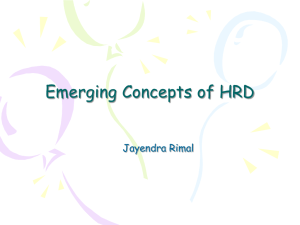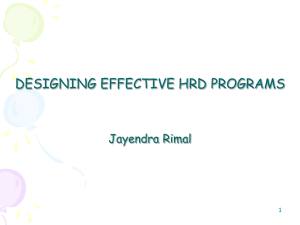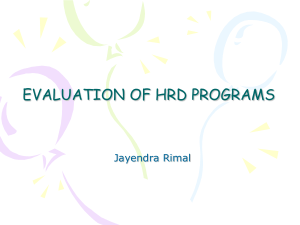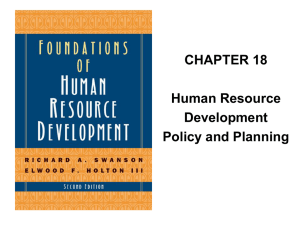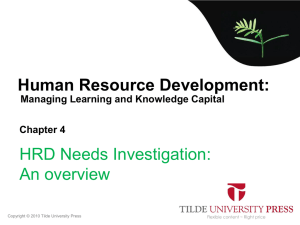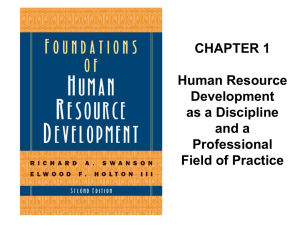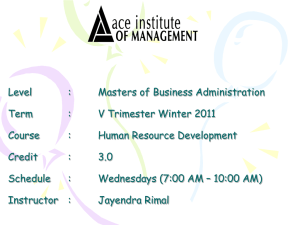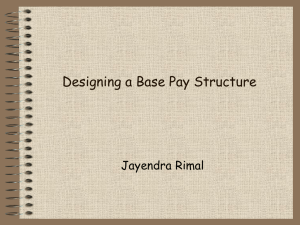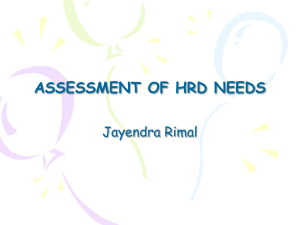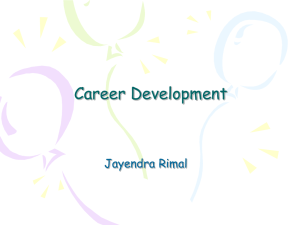1b.StrategicHRD
advertisement
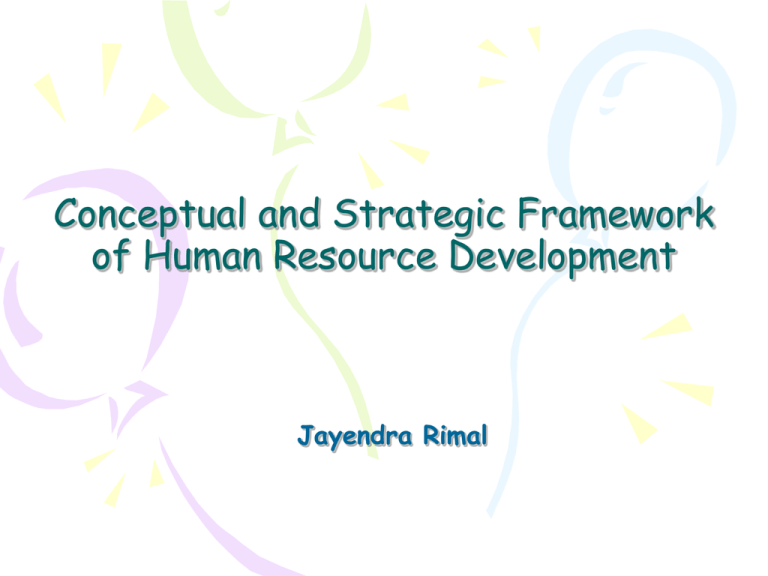
Conceptual and Strategic Framework of Human Resource Development Jayendra Rimal Some Definitions of Human Resource Department What is Human Resource Development? • A series of organizational activities conducted within a specified time and designed to produce behavioral change (Leonard Nadler, 1970) • Developing human potential in every aspect of lifelong learning (Craig, 1976) • Organized learning experiences provided for employees within a specified period of time to bring about the possibility of performance improvement and/or personal growth (Nadler & Nadler, 1989) • Holistic societal process of learning drawing upon a range of disciplines (Stead and Lee, 1996) Focus on Learning, Development, Change, Knowledge 04/01/2012 Jayendra Rimal/Ace HRD 2 HRD Concepts: Three Dimensions • Macro- economic dimension • Socio- economic dimension – Vocational training – Life skills • Organizational dimension 04/01/2012 Jayendra Rimal/Ace HRD 3 Macro-Economic Dimension • Long term objective: national economic growth • Immediate objective: improved efficiency, productivity and discipline of the labour force • Strategy: market oriented education and training, policy for labour demand, formalisation of the informal sector • Association of concepts: human capital formation, formal education and training, structural adjustment 04/01/2012 Jayendra Rimal/Ace HRD 4 Socio-Economic Dimension (Vocational Training) • Long term objective: raising of standard of living at community level • Immediate objective: income generation, improve technical skills, improve planning capacity for production • Strategy: (self) employment creation, skills training, small scale business management • Association of concepts: appropriate technology, individual entrepreneurships, informal education/training, income generation 04/01/2012 Jayendra Rimal/Ace HRD 5 Socio-economic Dimension (Life Skills) • Long term objective: raising of general life quality • Immediate objective: general empowerment, improve organizing and learning capacity • Strategy: community development, social awareness raising, social mobilization, literacy campaigns • Association of concepts: development by people, transformation for change, popular participation 04/01/2012 Jayendra Rimal/Ace HRD 6 Organisational Dimension • Long term objective: improved organisational performance in relation to mission, strategy and resources • Immediate objective: improved professional capacity to perform, receptivity towards organisational mission • Strategy: team building and individual training of staff and managers • Association of concepts: organisational development, institutional sustainability 04/01/2012 Jayendra Rimal/Ace HRD 7 Organizational HRD: Interpretations • Total institutional capacity development including: – Interventions focusing on improving total institutional capacity (leadership and governance, structure, human and other core resources, programme and process management and external linkages) – Too broader perspective – risk of dilution of primary focus (HR capacity development) 04/01/2012 Jayendra Rimal/Ace HRD 8 Organizational HRD: Interpretations • Individual capacity development including: – Learning activities focused on developing individuals’ capacity – Too narrow perspective – ignores the fact that HR capacity is capacity to perform, not merely the capacity of performer 04/01/2012 Jayendra Rimal/Ace HRD 9 Organizational HRD: Interpretations • Integrated process of including: – Developing competencies of individuals as well as – Improving organizational systems and environments that create and sustain opportunities to utilize and further develop competencies – For effective performance 04/01/2012 Jayendra Rimal/Ace HRD 10 HRD Concepts • A set of organised learning activities as well as • Work systems and environment improvement programs arranged for • Enhancing potentials and competencies of individuals and • Making utilisation of those abilities to • Attain effective performance and growth at the • Job, individual, and organisational levels in relation to the • Mission, strategies and resources of the organisation 04/01/2012 Jayendra Rimal/Ace HRD 11 HRD Concepts • A process and a function by which people in an organisation are helped, in a continuous and planned way, to – acquire and sharpen capabilities required to perform present and future jobs – develop general capabilities and use potentials for personal and professional development, and – develop an organizational culture and systems for maximum utilization of enhance competencies and potentials 04/01/2012 Jayendra Rimal/Ace HRD 12 HRD Concepts Development of work culture, environment and systems for organisational performance 04/01/2012 Jayendra Rimal/Ace HRD Organisational and individual goal achievement Development of job competencies and personal abilities of employees for present performance Increased performance HRD actions Development of potentials and careers of employees for future performance Outcomes of HRD Actions Enhance HR capacity Focus and Level of HRD Actions 13 HRD Goals • Human resource capacity enhancement • Human resource effectiveness • Increased human resource performance • Organisational and individual goals achievement 04/01/2012 Jayendra Rimal/Ace HRD 14 HRD Components • Individual development (job and personal KASOCs) • Career development (potential and professional growth) • Organisation development (improvement in work systems, structures, practices and culture supporting utilisation of capacity and promoting effective performance) 04/01/2012 Jayendra Rimal/Ace HRD 15 Strategic Management Strategic Management is primarily concerned with: o The full scope of the organization’s activities, o Matching activities of the organization to the environment, o Ensuring that the internal structures, practices and procedures enables organizations to achieve its goals, o Matching activities of organization to resource capability, assess how resources can be used to take advantage of opportunities and avoid threats, o Acquisition, divestment and reallocation of resources, o Translating complex and dynamic variables into a set of clear objectives . Strategy as a Plan, Pattern, Position and a Perspective 04/01/2012 Jayendra Rimal/Ace HRD 16 Core Competencies & Strategic Capabilities Core competencies provide the organization with a distinctive and sustainable competitive advantage: • • • • Value creation for customers Rarity compared to competition Non – imitability Non – substitubility Strategic capability is the ability of an organization to be an effective competitor by leveraging its resources and core competencies effectively to where they are needed 04/01/2012 Jayendra Rimal/Ace HRD 17 Strategic HRD • SHRD has a focus on holistic orchestration of learning • Ensures that learning is embedded in the fabric of the organization thereby creating a process in such a way that all individuals and teams are equipped with the skill, knowledge and competencies to undertake current and future tasks • Encompasses performance and reward management processes, ensures how these are applied and interpreted that enables and encourages learning and development to take place 04/01/2012 Jayendra Rimal/Ace HRD 18 Strategic HRD, contd… • HRD will take place irrespective of whether there is deliberate intention to facilitate it • Individuals learn by virtue of the experiences they undergo, called accidental learning/tacit knowledge • With a focus on enabling employees to be more customer responsive, team oriented, creative, innovative, business focused and strategically aware 04/01/2012 Jayendra Rimal/Ace HRD 19 Range of HRD Strategies • Level One: No systematic HRD – total reliance on natural, laissez-faire processes of HRD • Level Two: Isolated tactical HRD – in response to problems, crises or sporadically identified problems • Level Three: Integrated and coordinated structural and development tactics - with respect to career management and assisted learning that have a direct impact on the individual • Level Four: A HRD strategy to implement corporate policy – implementing policies through HR planning, providing a strategic direction, career management and learning, education and training 04/01/2012 Jayendra Rimal/Ace HRD 20 Range of HRD Strategies, contd… • Level Five: HRD strategy inputs to corporate policy formation – with respect to human assets, strengths, weaknesses and potential foe forecasting • Level Six: Strategic development of the management of corporate policy • Level Seven: Strategic leverage of learning & development processes to enhance the core competencies of the organization 04/01/2012 Jayendra Rimal/Ace HRD 21 Strategic HRD & Training Training regarded as a subset of HRD and consisting of: • Training on the job • Planned organizational experience • In house courses • Planned experiences outside the organization • External courses 04/01/2012 Jayendra Rimal/Ace HRD 22 Strategic HRD & Training Some conditions to Training & Development: • Alignment with organization objectives • Senior management support • Involvement of line managers • Quality of program design & delivery • Motivation of trainees • Integration with HRM policy 04/01/2012 Jayendra Rimal/Ace HRD 23 Thank you ! 04/01/2012 Jayendra Rimal/Ace HRD 24 Case Studies? • Restating important facts • Drawing inferences from the facts • Stating the problem • Developing alternate solutions and then stating the consequences of each • Determining and supporting a course of action 04/01/2012 Jayendra Rimal/Ace HRD 25
